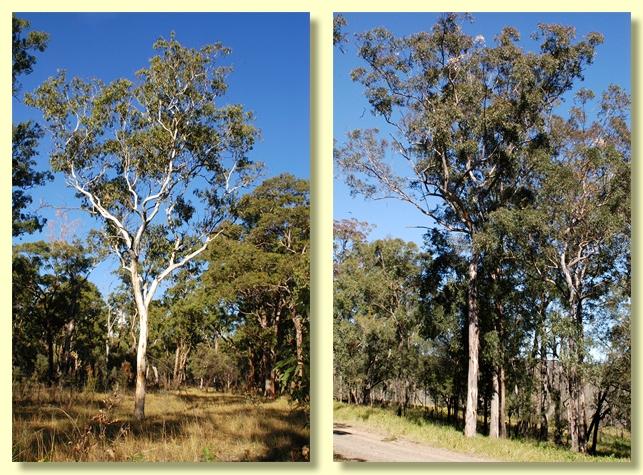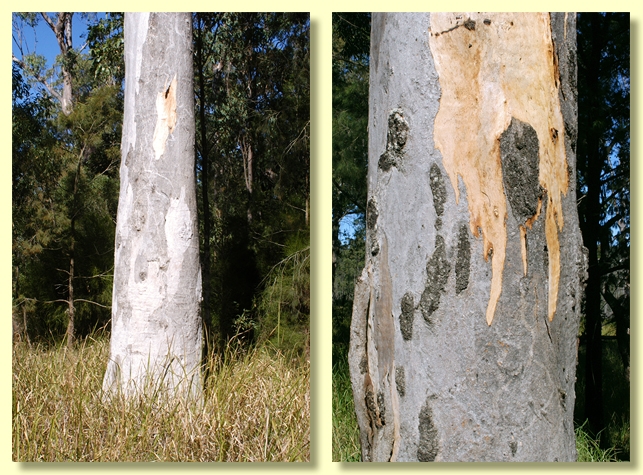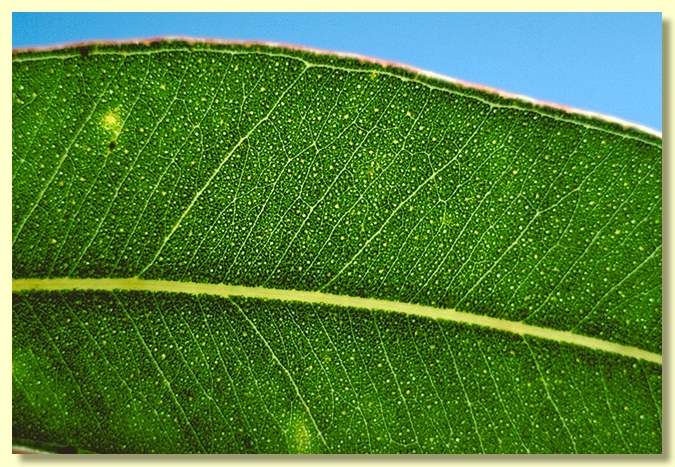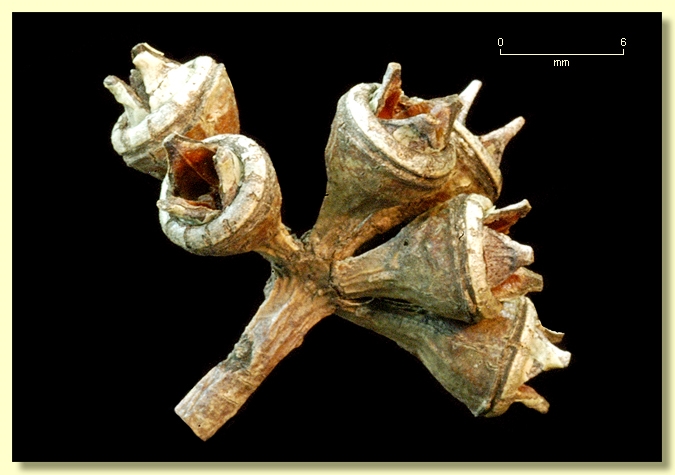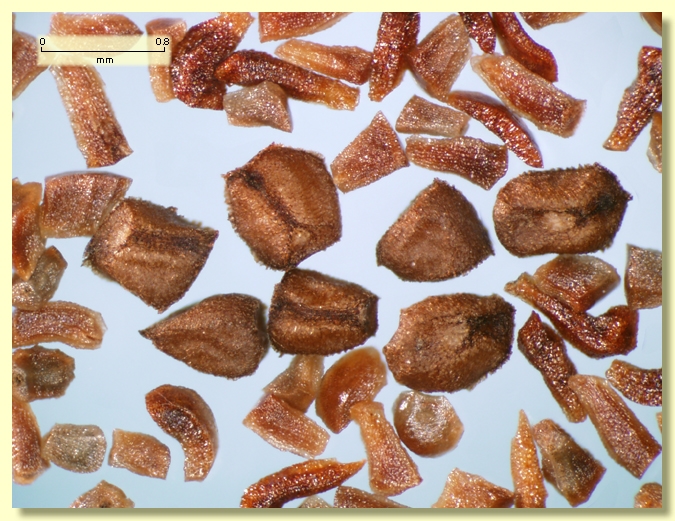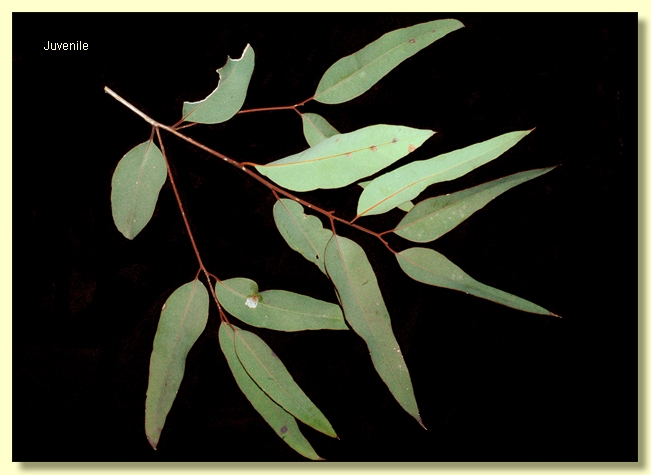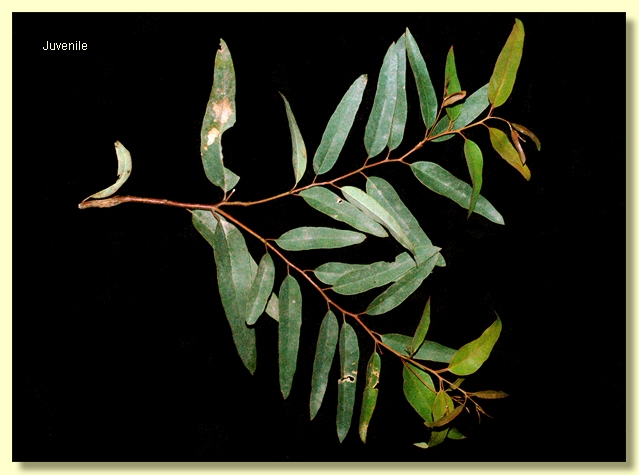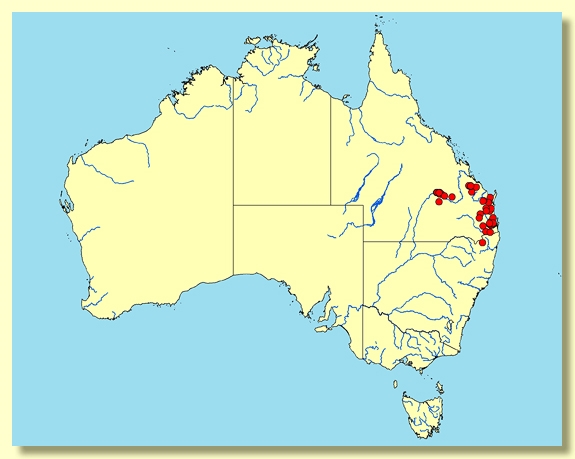Euclid - Online edition
Eucalyptus major
Eucalyptus | Symphyomyrtus | Latoangulatae | Lepidotae-Fimbriatae
Tree to 20 m tall. Forming a lignotuber.
Bark smooth, becoming granular with age, mottled grey, cream, pink, orange, shedding in strips.
Juvenile growth (coppice or field seedlings to 50 cm): stem square to round in cross-section; juvenile leaves always petiolate, opposite for 4 to 6 nodes then alternate, ovate, 7.5–10 cm long, 2.5–4 cm wide, discolorous, base rounded or tapering to petiole, green.
Adult leaves alternate, petiole 1.5–3 cm long; blade lanceolate to falcate, 9–20 cm long, (1.5)2–4(5) cm wide, base tapering to petiole, discolorous, glossy or dull, darker green above, paler below, strongly penniveined, densely to very densely reticulate, intramarginal vein parallel to and just within margin, oil glands mostly island.
Inflorescence usually axillary unbranched, peduncles 0.7–1.5 cm long, flattened, buds 7, shortly pedicellate to sometimes sessile (pedicels 0–0.5). Mature buds ovoid to diamond-shaped ((0.5)0.6–0.9(1.1) cm long, 0.4–0.5 cm wide), sometimes with slight longitudinal ribs on hypanthium, scar present, operculum conical to slightly beaked, stamens inflexed, anthers cuboid, versatile, dorsifixed, dehiscing by longitudinal slits (non-confluent), style long, stigma tapered, locules 3 or 4, the placentae each with 4 vertical ovule rows. Flowers white.
Fruit sessile or pedicellate (pedicels 0–0.5 cm long), obconical to cup-shaped, 0.3–0.5 cm long, 0.45–0.8 cm wide, sometimes faintly ribbed longitudinally, disc raised-convex to annular or level, valves 3 or 4, strongly exserted.
Seeds brown, 1–1.2 mm long, obliquely pyramidal to cuboid, more or less angular, dorsal surface smooth or shallowly pitted, hilum ± terminal.
Cultivated seedlings (measured at ca node 10): cotyledons oblong; stems square in cross-section; leaves always petiolate, opposite for ca 5 nodes then alternate, broadly lanceolate to ovate, 8–15 cm long, 2.5–6 cm wide, base tapering to rounded, margin entire, apex pointed, darker green above, paler beneath.
Flowering has been recorded in November.
A medium-sized to tall tree endemic to the coastal, subcoastal and central ranges of south-east Queensland from the Blackdown Tablelands, Kroombit Tops, Miriam Vale, Carnarvon Ranges area, south through the Murgon, Gympie, Nambour area, as far south as the suburbs of Brisbane (e.g. Mt Coot-tha, Norman Park, Seven Hills Nature Reserve). Eucalyptus major is characterized by its dull granular smooth mature bark, its strongly discolorous adult leaves paler on the underside and with widely spreading side-veins and dense to very dense reticulation, and its small buds and fruit.
Eucalyptus major belongs in Eucalyptus subgenus Symphyomyrtus section Latoangulatae because cotyledons are bilobed, leaves are discolorous and have side-veins at a wide angle to the midrib, buds have two opercula and fruit have exserted valves. Within this section, it is one of six species forming series Lepidotae-Fimbriatae (the Grey gums) with ovules in 4(6) rows and the bark smooth throughout becoming granular with age. The series Lepidotae-Fimbriatae can be informally divided further into two groups based on seed colour and the presence or absence of small teeth on the seed edge. E. punctata, E. canaliculata, E. longirostrata and E. grisea all have black seed that are prominently toothed along the edges. E. propinqua and E. major have brown to light brown seed that have a much smoother surface texture than those of the other grey gums mentioned above, lacking the prominent teeth on the seed edge. Also the bark of E. propinqua and E. major tends to shed in strips rather than patches like the other grey gums.
E. major is very closely related to E. propinqua and may be better placed, where it was originally described by Maiden, as a subspecies of E. propinqua. It differs only marginally by having coarser leaves and slightly larger buds and fruit with shorter pedicels. Buds and fruit are sometimes almost sessile in E. major and usually distinctly pedicellate in E. propinqua.
E. major is distinguished from the other grey gums by its small buds and fruits and by its brown, relatively smooth seeds (black, prominently ribbed and toothed for the other grey-gums).
Within its area of occurence, E. major may be confused with some red gums (e.g. E. tereticornis ). The red gums, which can sometimes have the dull granular-type bark of the grey gums, are easily distinguished by having concolorous adult leaves with moderate reticulation.
Eucalyptus major: Latin majus - greater, referring to the coarser leaves, buds and fruit than those of E. propinqua.

